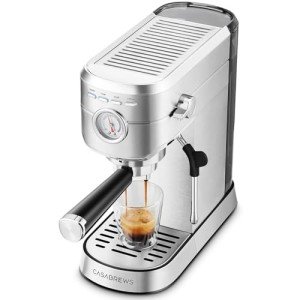The Art of Italian Espresso Machines: A Brewed Tradition
Italian espresso machines are not just home appliances; they are an important part of Italy's abundant coffee culture, representing a blend of artistry, engineering, and design. Coffee aficionados around the globe acknowledge the importance of high-quality espresso, a staple of Italian life and cuisine. This short article explores the history, mechanics, types, and factors to think about when buying an Italian espresso machine, reflecting the depth of this cherished drink and its brewing approaches.
History of Espresso Machines
The espresso machine's evolution dates back to the early 20th century in Italy, where coffee was not simply a beverage but an important social ritual. her comment is here to brew espresso begun with simple, stove-top designs, gradually developing into complex machines that might replicate the best brew.
- 1901-- The First Espresso Machine: The very first steam-powered espresso machine, called the "Ideale," was developed by Luigi Bezzera. This machinery marked a turning point in espresso brewing.
- 1938-- The Lever Machine: The introduction of the lever machine made it simpler to control the pressure utilized in espresso extraction, boosting taste consistency.
- 1947-- The Automatic Machine: Reaching more consumers, Gaggia launched the first automatic espresso machine, further promoting espresso bars.
- 2007-- The Digital Age: Technological advancements resulted in the birth of fully programmable machines, permitting users to tailor their developing settings to achieve a personalized coffee experience.
Secret Features of Italian Espresso Machines
Italian espresso machines embody accuracy, workmanship, and innovation. Here are some crucial elements that highlight their significance:
| Feature | Description |
|---|---|
| Boiler Type | Determines how heat is produced and kept. Typical types consist of single boiler, dual boiler, and heat exchanger. |
| Group Heads | Where the coffee is brewed; commercial machines frequently have several group heads for effectiveness. |
| Pressure Control | Essential for accomplishing the best espresso; most machines operate at 9 bars of pressure. |
| Frothing Capabilities | The steam wand enables milk frothing, essential for beverages like cappuccino and latte. |
| Build Quality | The products utilized (stainless-steel, brass, and so on) impact durability and heat retention. |
Types of Italian Espresso Machines
Picking the best machine depends upon user preferences, budget, and intended use. Below are the main kinds of Italian espresso machines:
Manual Espresso Machines
- Pros: Offer full control over the brewing procedure, permitting for an individualized touch.
- Cons: Require ability and practice, can be labor-intensive.
Semi-Automatic Machines
- Pros: Provide a balance between automated and manual procedures; users manage water circulation.
- Cons: Can have a steeper learning curve than fully automatic machines.
Totally Automatic Machines
- Pros: Simplify the brewing procedure with push-button operations; ideal for newbies.
- Cons: May sacrifice a few of the subtleties of manual brewing.
Super-Automatic Machines
- Pros: Grind, tamp, brew, and froth immediately; practical for busy way of lives.
- Cons: Less control over the brewing variables, potential for a less authentic espresso experience.
Buying Guide: Factors to Consider
Selecting the ideal Italian espresso machine can be difficult, however considering the following factors can streamline the decision-making procedure:
- Budget: Italian espresso machines vary from affordable to high-end designs, so set a budget upfront.
- Use Frequency: Evaluate how often you will use the machine; day-to-day users may want a more resilient choice.
- Area: Measure your kitchen area or counter space; some machines can be large and require sufficient clearance.
- Maintenance: Consider ease of cleaning; machines with removable parts or integrated cleansing functions may minimize maintenance.
- User Skill Level: Beginners may choose completely or semi-automatic machines, while knowledgeable baristas can manage manual machines.
- Brand name Reputation: Research brand names known for quality, such as Breville, Gaggia, and La Marzocco.
Popular Italian Espresso Machine Brands
Italian craftsmanship is renowned for producing some of the very best espresso machines worldwide. Here are top brand names worth considering:
- Gaggia: Known for its home espresso machines and affordability.
- La Marzocco: A superior brand name understood for its commercial-grade machines and ingenious innovation.
- Rancilio: Renowned for its durable build and professional-quality machines appropriate for home and commercial use.
- Sage/Breville: Offers advanced features and user-friendly styles, perfect for both beginners and enthusiasts.
Frequently asked questions
What is the difference in between espresso and routine coffee?
Espresso is a focused coffee brewed by requiring warm water through finely-ground coffee under pressure. It has a thicker consistency, richer flavor, and higher caffeine concentration than regular coffee.
Can I make milk-based drinks with an espresso machine?
Yes, many Italian espresso machines feature a steam wand to froth milk for beverages like coffees, lattes, and macchiatos.
How typically should I clean my espresso machine?
Regular maintenance is necessary. Usually, a comprehensive cleaning is recommended every few weeks, while descaling ought to be done every 1 to 3 months, depending on water firmness.
What is the perfect pressure for developing espresso?
The ideal pressure for developing espresso is around 9 bars. This pressure ensures the ideal extraction of tastes from the coffee premises.
Are more costly machines worth the financial investment?
Higher-end machines often utilize much better materials and innovation, providing improved resilience and more constant outcomes. For major coffee fans, buying an excellent machine can raise the espresso experience substantially.
Italian espresso machines are a lot more than simple brewing devices; they are a celebration of a cultural custom that has actually affected coffee usage worldwide. With different models readily available to fit any user's requirements-- ranging from amateurs to experienced baristas-- there is an Italian espresso machine completely matched for everyone. As you start your espresso journey, comprehending the history, mechanics, and choices will enrich your experience and gratitude for this time-honored beverage. Whether you look for to recreate a coffee shop ambiance at home or refine your brewing technique, these machines are capable of delivering extraordinary cups of espresso decorated with the abundant history of Italian coffee culture.

